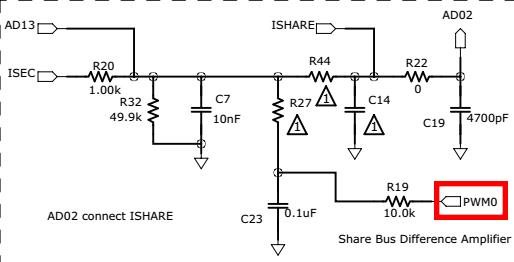Tool/software: Code Composer Studio
Hello, I was recently learning the UCD3138HSFBEVM_029 demo board .
I met some questions about the current sharing mode.
Firstly, I made two boards in current sharing operation. The test results showed the current sharing ratio in steady state is nearly perfect, when Vin is at 36V and load is over 40A. But when Vin is higher and load is lower, the the current sharing ratio wasn't as good as in before situations. So I expect to know what causes and what factors affect the current sharing ratio?
Secondly,I read the codes about handle_current_sharing(void), there are current_share_ki, and current_share_kp parameters, Whether these parameters have an effect on current sharing ratio in deferent operation situations?Is there any possibility to ensure the current sharing ratio is good no matter the bords works at a larger range of Vin or a a larger range of load ?if it can be realized, what should I do? please give me some suggestions, thank you very much!
Thirdly, I read the code:
void enable_current_sharing(void)
{
#ifdef CURRENT_SHARING_ENABLE
FeCtrl0Regs.EADCDAC.bit.DAC_DITHER_EN = 1;
//3 for pass through
//1 for DPWM current source control 250 uA into 10 kOhm at 100% duty cycle.
MiscAnalogRegs.CSCTRL.bit.TEST_MODE = 1;
//300 kHz
MiscAnalogRegs.CSCTRL.bit.DPWM_PERIOD = 108;
// MiscAnalogRegs.CSCTRL.bit.DPWM_DUTY = 54;
#endif
}
MiscAnalogRegs.CSCTRL.bit.DPWM_PERIOD = 108;
What is the relationship between this DPWM_PERIOD value and the Dpwm0Regs.DPWMPRD.all = PERIOD Value?
Looking forward to your reply, thanks.




